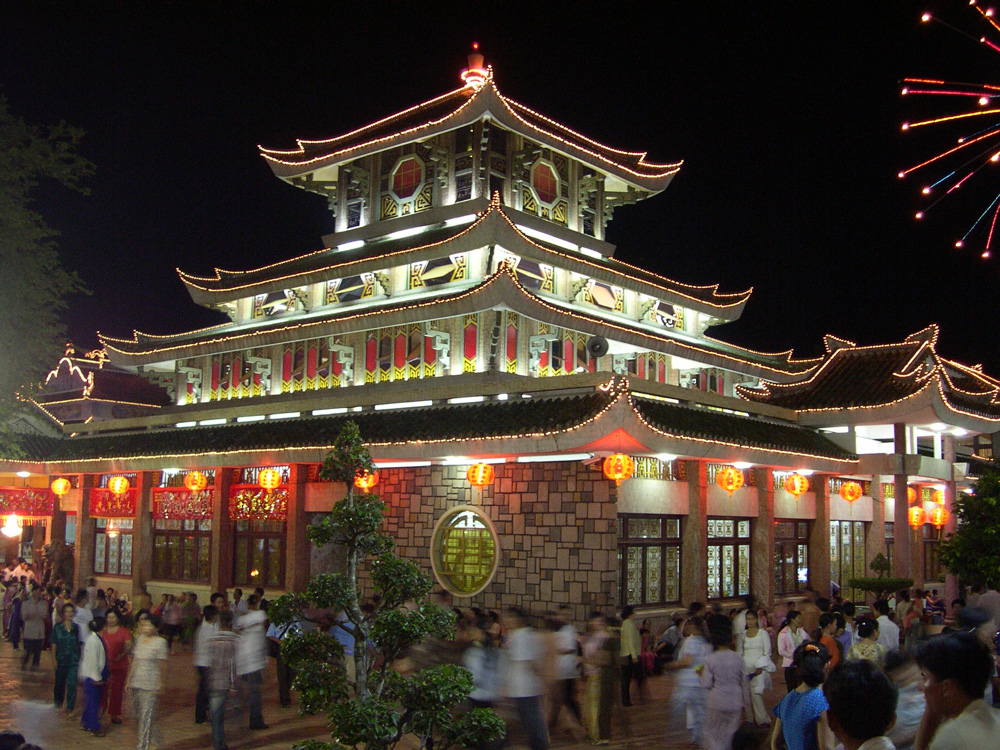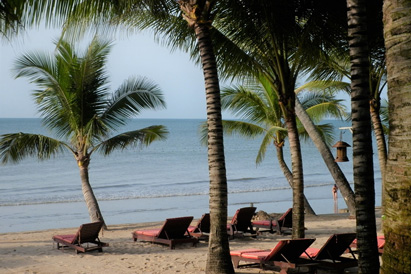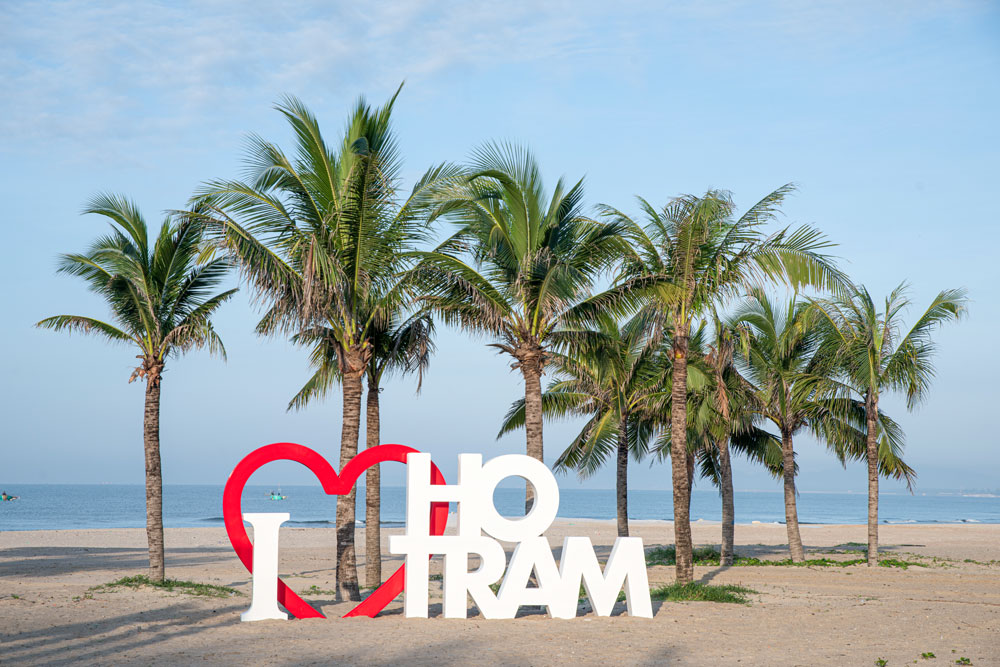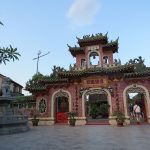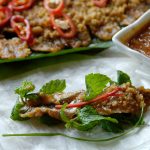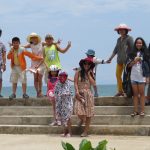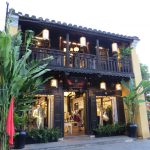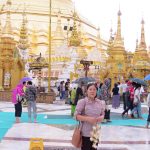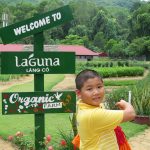Getting up in the early morning in sounds of birds singing just outside my room’s door, I felt quite excited to find out that I was staying in the only resort situated in forest, among the lush hills of Nui Chua National Park, Ninh Thuan Province where is well known as home to more 1,500 plant species, 160 bird species and 60 species of mammals.

Simply I started my new day here by walking and breathing deeply in fresh air, in light aroma of wild flowers fleeting, in sound of leaves whispering in the wind and of birds twittering together. I enjoyed the sounds of nature which Masanobu Fukuoka (1913-2008), a Japanese farmer and philosopher described them interestingly as “truly music, pure music” in his famous book “The One-Straw Revolution”. And I was practising Fukuoka’s spirit in listing and learn from nature with happiness.

I was filled with the healthy energy before starting the trekking to Goga peak, a small mountain among Nui Chua Mountain located by Vinh Hy Bay, recommended as the best site to see panorama of Vinh Hy Bay and Nui Chua Mountain in the sunrise. The weather of the day was very nice, with blue sky and first sunlight shining through undulating hills. My companion, Hien, a local guide joined in the trekking with me.
We walked and talked about this land where he was born and grew up at Vinh Hy fishing village under the foot of Nui Chua Mountain. Hien showed me a kind of woody tree called “găng” tree with its wide and short canopy in the shape of an umbrella. Găng tree had many beautiful green fruits like peaches but it is uneatable fruit. He told that this tree concerned in the name of this land in the past. As the story of old people in the village, Vinh Hy Bay in the past had name “Vũng Găng” (Găng Bay) where there were a lot of Găng trees growing naturally around the bay. In American War, villagers had to leave for Phan Rang City to avoid the fighting for many times. Then, at peace, they came back the village and changed its name into “Vĩnh Hy Village” (in Vietnamese, ‘Vĩnh’ is forever and ‘Hy’ is hope) which showed their wish that they could settle here forever.

The tiny trail taking to the Goga peak had a lot of shrubs, catus and beautiful wild flowers in different colours at two sides. Then we climbed up big rocks or even went through thick bushes before we set our feet to the mountain top where there were just some big rocks arranged ingenuously by nature. It’s amazing to see the picturesque panorama of Vinh Hy Bay and Nui Chua Mountain from the height with a great view of 360 degree, with immense sea and tranquil fishing village in the sunrise, with cliffs standing by the beach, with majestic mountains for a distance in the west linking vast green carpet of forest before my eye. I felt as if the wind could blow me to fly into the air when I stood at such tottery height.

Hien showed me his Vinh Hy village in a distance below where is protected by mountains surrounding. As most of villagers, his family has lived here for many generations by fishing which depended mostly on the sea. Hien said that Vinh Hy Bay was famous for lobster, mackerel, abalone and squid. Hien also showed me a rock mountain to the south of Vinh Hy Bay where we could see from Goga peak, that was rock park with hundreds of rocks arranged by nature like sculptures in strange shapes or the coral preserving area with clear blue water and tourists can sit on the boat with glass bottom to see coral below the sea.

In recent years, Nui Chua National Park has become a new destination in Ninh Thuan for tourists who love to discover wild nature, pristine beaches or to conquer the height and obstacles of mountains or to experience a high-class holiday at one of the best resorts in Vietnam, Amanoi. For me, I had interesting time here to live with nature. I liked wandering in the forest to see and take photos plants with big roots growing on rocks, the collection of colourful wild flowers and strange fruits. It’s exciting for me to sit quietly somewhere in the forest, then zoomed in my camera to observe a lovely chipmunk climbing on the tree and eating the fruit or birds with their beautiful feathers and then chasing each other from tree to other one.
I really had an unforgettable experience when I joined in Wellness Immersion program at the resort where I stayed with Dr Lucas. He was a conscientious young American doctor with his passion pursuing oriental medicine who guided me to experience with yoga, tai chi, Qigong and meditation as well as his treatments with herbals and acupuncture. I loved to do exercises every day with Lucas and therapists in fresh air of forest, feeling my breath in harmony with nature. That was marvelous time for me to learn how to relax and make balance for my body and mind.
Visiting the village of Raglai ethnic people
Raglai is native ethnic people living in Nui Chua Mountain. Nowadays, they have lived mostly at Cau Gay Village and Da Hang village at the foot of the mountain among Nui Chua National Park. In the past, Raglai people’s original life was mainly based on the forest. When Nui Chua has become National Conservation Park, they were encouraged to leave the forest to begin a new life in new villages. They were trained new works such as growing rice, fishing, feeding bee to collect honey or making handicrafts.

Going through a hanging bridge, we arrived in Cau Gay Village. The main road of the village was full of wild lily flowers. I saw children playing game with their innocent laughing on the rice filed after harvest and women carrying “gui” (a rattan or bamboo basket) on their shoulder. Villagers feed a lot of cows, goats and black pigs and let them wandering in the village to look for food. The life here looked peaceful and tranquil. In a house, villagers gathered together to sing “karaoke” joyfully. I found that most of houses was small and simple and were built in concrete but there were still some typical houses in traditional way of Raglai people with walls made from clay and straw. In the village, there are a kindergarten, a primary school and Raglai people’s Display House where tourists can learn more about the village history and buy some handicrafts made from seeds of trees collected from the forest.

Actually, modern life brings better conditions for them but also is losing their traditions. According to Ms Nguyen, Marketing and communication Manager of Amanoi Resort, the resort is making a community project including building a traditional house of Raglai people in the village where will display and introduce their culture and original objects, teaching English for children and youth in the village and joining together with villagers to collect rubbish around the village as well as educating awareness to protect the environment.
Photo: Thanh Van



